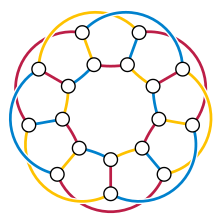In graph theory, a uniquely colorable graph is a k-chromatic graph that has only one possible (proper) k-coloring up to permutation of the colors. Equivalently, there is only one way to partition its vertices into k independent sets and there is no way to partition them into k − 1 independent sets.
Examples
A complete graph is uniquely colorable, because the only proper coloring is one that assigns each vertex a different color.
Every k-tree is uniquely (k + 1)-colorable. The uniquely 4-colorable planar graphs are known to be exactly the Apollonian networks, that is, the planar 3-trees.
Every connected bipartite graph is uniquely 2-colorable. Its 2-coloring can be obtained by choosing a starting vertex arbitrarily, coloring the vertices at even distance from the starting vertex with one color, and coloring the vertices at odd distance from the starting vertex with the other color.
Properties
A uniquely k-colorable graph G with n vertices has at least m ≥ (k−1)n − k(k−1)/2 edges. Equality holds when G is a (k−1)-tree.
Related concepts
Minimal imperfection
A minimal imperfect graph is a graph in which every subgraph is perfect. The deletion of any vertex from a minimal imperfect graph leaves a uniquely colorable subgraph.
Unique edge colorability

A uniquely edge-colorable graph is a k-edge-chromatic graph that has only one possible (proper) k-edge-coloring up to permutation of the colors. The only uniquely 2-edge-colorable graphs are the paths and the cycles. For any k, the stars K1,k are uniquely k-edge-colorable. Moreover, Wilson (1976) conjectured and Thomason (1978) proved that, when k ≥ 4, they are also the only members in this family. However, there exist uniquely 3-edge-colorable graphs that do not fit into this classification, such as the graph of the triangular pyramid.
If a cubic graph is uniquely 3-edge-colorable, it must have exactly three Hamiltonian cycles, formed by the edges with two of its three colors, but some cubic graphs with only three Hamiltonian cycles are not uniquely 3-edge-colorable. Every simple planar cubic graph that is uniquely 3-edge-colorable contains a triangle, but W. T. Tutte (1976) observed that the generalized Petersen graph G(9,2) is non-planar, triangle-free, and uniquely 3-edge-colorable. For many years it was the only known such graph, and it had been conjectured to be the only such graph but now infinitely many triangle-free non-planar cubic uniquely 3-edge-colorable graphs are known.
Unique total colorability
A uniquely total colorable graph is a k-total-chromatic graph that has only one possible (proper) k-total-coloring up to permutation of the colors.
Empty graphs, paths, and cycles of length divisible by 3 are uniquely total colorable graphs. Mahmoodian & Shokrollahi (1995) conjectured that they are also the only members in this family.
Some properties of a uniquely k-total-colorable graph G with n vertices:
- χ″(G) = Δ(G) + 1 unless G = K2.
- Δ(G) ≤ 2 δ(G).
- Δ(G) ≤ n/2 + 1.
Here χ″(G) is the total chromatic number; Δ(G) is the maximum degree; and δ(G) is the minimum degree.
Notes
- ^ Fowler (1998).
- Mahmoodian (1998).
- Truszczyński (1984); Xu (1990).
- Thomason (1982).
- Bollobás (1978); Schwenk (1989).
- belcastro & Haas (2015).
- ^ Akbari et al. (1997).
- Akbari (2003).
References
- Akbari, S. (2003), "Two conjectures on uniquely totally colorable graphs", Discrete Mathematics, 266 (1–3): 41–45, doi:10.1016/S0012-365X(02)00797-5, MR 1991705.
- Akbari, S.; Behzad, M.; Hajiabolhassan, H.; Mahmoodian, E. S. (1997), "Uniquely total colorable graphs", Graphs and Combinatorics, 13 (4): 305–314, doi:10.1016/S0012-365X(02)00797-5, MR 1485924.
- belcastro, sarah-marie; Haas, Ruth (2015), "Triangle-free uniquely 3-edge colorable cubic graphs", Contributions to Discrete Mathematics, 10 (2): 39–44, arXiv:1508.06934, doi:10.11575/cdm.v10i2.62320, MR 3499076.
- Bollobás, Béla (1978), Extremal Graph Theory, LMS Monographs, vol. 11, Academic Press, MR 0506522.
- Fowler, Thomas (1998), Unique Coloring of Planar Graphs (PDF), Ph.D. thesis, Georgia Institute of Technology Mathematics Department.
- Hillar, Christopher J.; Windfeldt, Troels (2008), "Algebraic characterization of uniquely vertex colorable graphs", Journal of Combinatorial Theory, Series B, 98 (2): 400–414, arXiv:math/0606565, doi:10.1016/j.jctb.2007.08.004, MR 2389606, S2CID 108304.
- Mahmoodian, E. S. (1998), "Defining sets and uniqueness in graph colorings: a survey", Journal of Statistical Planning and Inference, 73 (1–2): 85–89, doi:10.1016/S0378-3758(98)00053-6, MR 1655213.
- Mahmoodian, E. S.; Shokrollahi, M. A. (1995), "Open problems at the combinatorics workshop of AIMC25 (Tehran, 1994)", in C. J., Colbourn; E. S., Mahmoodian (eds.), Combinatorics Advances, Mathematics and its applications, vol. 329, Dordrecht; Boston; London: Kluwer Academic Publishers, pp. 321–324.
- Schwenk, Allen J. (1989), "Enumeration of Hamiltonian cycles in certain generalized Petersen graphs", Journal of Combinatorial Theory, Series B, 47 (1): 53–59, doi:10.1016/0095-8956(89)90064-6, MR 1007713.
- Thomason, A. G. (1978), "Hamiltonian cycles and uniquely edge colourable graphs", Advances in Graph Theory (Cambridge Combinatorial Conf., Trinity College, Cambridge, 1977), Annals of Discrete Mathematics, vol. 3, pp. 259–268, MR 0499124.
- Thomason, Andrew (1982), "Cubic graphs with three Hamiltonian cycles are not always uniquely edge colorable", Journal of Graph Theory, 6 (2): 219–221, doi:10.1002/jgt.3190060218, MR 0655209.
- Truszczyński, M. (1984), "Some results on uniquely colourable graphs", in Hajnal, A.; Lovász, L.; Sós, V. T. (eds.), Finite and Infinite Sets. Vol. I, II. Proceedings of the sixth Hungarian combinatorial colloquium held in Eger, July 6–11, 1981, Colloq. Math. Soc. János Bolyai, vol. 37, North-Holland, Amsterdam, pp. 733–748, MR 0818274.
- Tutte, William T. (1976), "Hamiltonian circuits", Colloquio Internazionale sulle Teorie Combinatorie (Rome, 1973), Tomo I, Accad. Naz. Lincei, Rome, pp. 193–199. Atti dei Convegni Lincei, No. 17, MR 0480185. As cited by belcastro & Haas (2015).
- Xu, Shao Ji (1990), "The size of uniquely colorable graphs", Journal of Combinatorial Theory, Series B, 50 (2): 319–320, doi:10.1016/0095-8956(90)90086-F, MR 1081235.
- Wilson, R. J. (1976), "Problem 2", in Nash-Williams, C. St. J. A.; Sheehan, J. (eds.), Proc. British Comb. Conf. 1975, Winnipeg: Utilitas Math., p. 696. As cited by Thomason (1978).